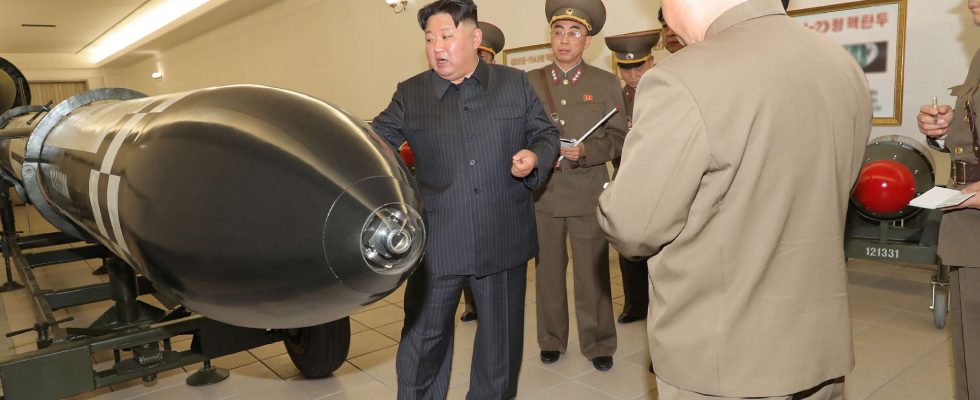Photos show the North Korean leader surrounded by uniformed officers, inspecting a row of what appear to be tactical nuclear warheads. Kim Jong-un thus unveiled in state media on Monday, March 27, new miniature weapons which, according to tables and diagrams posted on the walls, could be mounted on different types of missiles.
For several days, North Korea has been increasing military announcements relating to atomic weapons, in a clear attempt to intimidate the West. These North Korean provocations, which threaten “international peace and security”, according to Paris, come as a US Navy aircraft carrier arrived in South Korea on Tuesday. Relations between the two Koreas are also at their lowest in years, with Seoul and Washington increasing joint military maneuvers while Pyongyang carries out increasingly provocative weapons tests.
Increase the production of military nuclear material
On the same day, Kim Jong-un “encouraged the continued production of powerful nuclear weapons”, according to the KCNA agency. After speaking with officials from the country’s nuclear weapons institute, the leader also said North Korea must be prepared to use its nuclear weapons “anywhere and anytime”.
When the country has “perfectly” prepared its nuclear weapons systems, “the enemy will fear us and dare not challenge the sovereignty of our state, our system and our people,” Kim Jong-un told reporters. the same source. Last year, North Korea declared itself an “irreversible” nuclear power, and the dictator recently called for an “exponential” increase in the production of weapons, including tactical nuclear weapons.
Testing an “underwater nuclear drone”
North Korea’s military also said on Tuesday it had carried out a second test of what it described as an “underwater nuclear attack drone”, the first test of which took place last week. The new weapon, called Haeil (tsunami in Korean), was first tested, according to Pyongyang, in response to recent US-South Korean military drills, the largest in five years.
If Seoul questions the existence of these underwater nuclear drones, Pyongyang maintains that Haeil maneuvered underwater “for 41 hours and 27 minutes following a simulated route of 600 kilometers” before exploding on a target in the off North Hamgyong province early Monday, according to KCNA. The test “demonstrated all strategic qualifications as well as the security and reliability of the weapons system”, according to the agency.
Russia has reportedly developed a similar weapon, the Poseidon nuclear torpedo, but mastering the complex technology required for this type of weaponry is still beyond Pyongyang’s reach, experts say.
A 7th nuclear test in preparation?
Tuesday’s announcement of the nuclear-related information by state media seems to indicate that the country is preparing for a seventh nuclear test, analysts said. Cheong Seong-chang, a researcher at the Sejong Institute, told AFP that the hard line adopted by Pyongyang “probably aims to justify its weapons tests and a nuclear test in the future”. “The possibility that as a next step North Korea will carry out a seventh nuclear test with these tactical nuclear warheads has increased,” he added.
North Korea has warned of its “overwhelming response to every joint training between South Korea and the United States, but given the number of missiles fired, it cannot continue like this indefinitely”, also estimated Park Won- gon, a professor at Ewha University in Seoul, told AFP. “If this is the case, the seventh nuclear test will mark a sort of end, they will declare themselves a nuclear power and will turn to negotiation with the United States,” he concludes.
